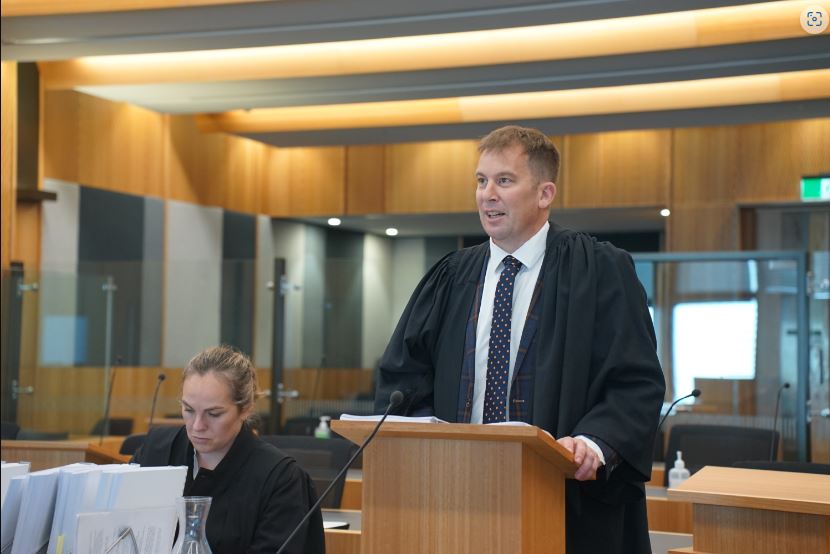A second Mid Canterbury irrigation scheme is under judicial scrutiny and in the hands of a High Court judge.
He’s Judge Cameron Mander, who will release his decision at a later date after the conclusion of a High Court hearing in Christchurch this week.
The issue involves MHV (Mayfield Hinds Valetta) Limited, who have found themselves in the crossfire of a case between the Environmental Law Initiative (ELI) and our regional council, Environment Canterbury (ECan).
The case revolves around ECan’s compliance with the Resource Management Act 1991 (RMA) and environmental policy.
In 2021, ECan granted MHV a discharge consent, allowing the irrigation scheme to release “contaminants” like nitrogen fertiliser onto land where it might end up in nearby rivers and streams. Many of MHV’s farmers have land connected to the region’s rivers and smaller streams.
But ELI, a charity organisation of environmental researchers and lawyers, believe the consent was unlawfully granted. They applied for judicial review focussed around two key issues – the consent’s non-compliance with the RMA and coastal policy, and a lack of public notification.
ELI lawyer Adam McDonald said ECan had failed to correctly apply section 107 of the RMA – a point argued in their successful case against the Ashburton Lyndhurst Irrigation scheme (ALIL) last year.
“MHV, in my position, makes the exact same flawed position that ALIL made,” he said to Judge Mander.
Section 107 prevents the granting of discharge permits if the discharge would significantly contaminate waterways – by making them look dirty, smell bad or harmful to aquatic life – even after dilution while flowing downstream.
McDonald said commissioner Sharon McGarry, who granted both MHV and ALIL’s consents, had unlawfully done so on “speculation”.
McGarry granted MHV’s consent on conditions that they’d reduce pollutants like nitrogen in connected waterways over the permit’s tenure.
“The consent needed to comply with 107 at the outset, and it did not,” McDonald said.
Section 107 was amended by the Government last year and it now permits consents, which significantly impact water quality if steps are taken to improve it overtime.
He said the “after-the fact” law changes were “entirely irrelevant” to this case.
McDonald also said several coastal policies, like the New Zealand Coastal Policy Statement and Regional Coastal Environment Plan for the Canterbury region, should have been included in the proposal.
“Despite my friends’ contentions, there is at least a small part of the coastal marine area [within] the irrigation scheme.
“MHV’s assessment of environmental effects notes that the Longbeach coastal wetlands system is in that area.”
He also noted a number of vulnerable native species in MHV territory, like the Torrentfish and Canterbury Mudfish.
“The effects on coastal features such as wetlands were just overlooked.”
MHV’s lawyers said the commissioner had “confidence” that sustainability promises would be met, more so than in the ALIL case.
“MHV’s got an obligation in its consent to gather five years of data, and various steps in the consent to measure whether there’s a variation on [nitrogen],” lawyer Ben Williams said.
He also said MHV was subject to specific rules in the Canterbury Land and Water Regional Plan that ALIL had not been
If the consent was revoked, each affected farmer would have to apply for their own permit, Williams said.
It was more efficient, and likely better for the environment for MHV to hold an overarching consent.
The cooperative has done a lot to support the community and their farmers in taking up sustainable practices, like helping found the Hekeao / Hinds Water Enhancement Trust (HHWET) who manage New Zealand’s largest groundwater rehabilitation project.
“A quashed consent would create uncertainty for the farming and wider communities of Mid Canterbury,” Williams said.
ELI’s second point revolved around ‘limited notification’.
If a consent negatively affects someone, those people must be notified and able to submit statements ahead of the consent being granted.
Only te Rūnanga o Arowhenua, representing te Rūnanga o Ngāi Tahu, were alerted to the consent as part of a “limited notification’.
ELI said the discharge affects water supplies linked to Carew School and the Hinds township, and a lack of data provided by MHV warranted public notification.
“The fundamental rights of those who take their drinking water from nearby suppliers were just overlooked,” McDonald said.
“This is just the sort of problem [that] public notification is meant to prevent.”
ECan lawyer Kate Dickson said there was extensive collaboration between MHV and ECan staff over an 18-month timeframe.
She said the request was responded to “in substance” – not in one go, but through various meetings, emails and reports.
“The council had detailed and comprehensive information before it.”
There was no special case that warranted public notification, she said.
ELI’s final sticking point was that ECan should have revoked their decision to grant MHV a consent immediately following the ALIL decision.
In 2024, the Ashburton Lyndhurst Irrigation scheme lost a similar High Court review and lost their resource consent as a result.
“The commissioner’s flawed approach in the ALIL case and in this one are strikingly similar,” McDonald said.
ECan said the council does not, and should not, have the ability to cancel consents at will.
“There would be chaos for those who hold resource consents, chaos for those administering the system, being councils, and chaos with respect to the system itself,” lawyer Philip Maw said.
He also reminded Judge Mander that the ALIL case, which ELI based much of their argument on, was not solid ground – it was at the Court of Appeal and could be overturned.
Judge Mander will consider the submissions, and release his decision at a later date.
By Anisha Satya






